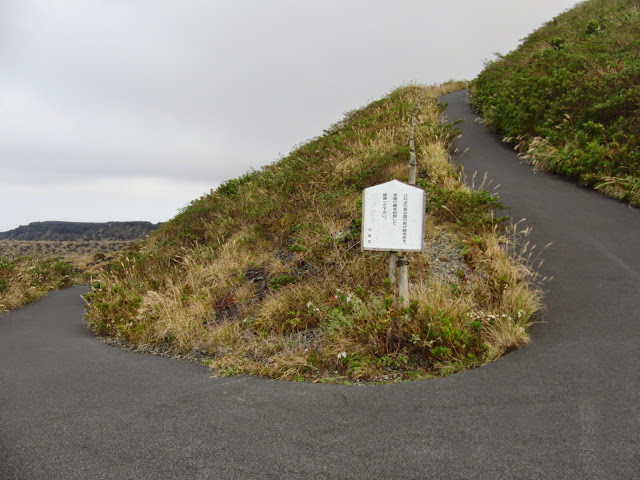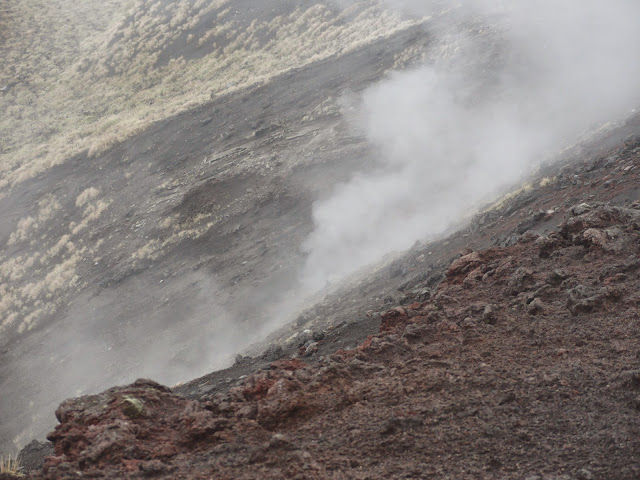I talked a little in the previous post about Mount Mihara that lies in the centre of the island and dominates the landscape and how it is one of the most active volcanoes in the world. Well, today I was going to climb it.
I woke up at an early (for me) time and had a look around the hotel grounds. The hotel is only small and consists of only 3 rooms, so it is very quiet. The grounds and the buildings were quite nice and for only $100 per night, it was reasonable value.
As I said, $100 per night, and check out the breakfast that you get!
After downing that, I was well and truly fuelled to take on whatever Mount Mihara could throw at me!
My lovely host took me down to the Motomachi Port where I could catch the bus from and after a 20 minute bus ride, I had arrived at the foot of Mount Mihara. It was the foot of Mount Mihara, but it was still quite elevated and the views back down to the port were nice. You could even see boats leaving the port.
The collection of buildings where the bus had dropped me off contained a bus shelter, toilets, a couple of shops and restaurants, and a souvenir shop. I will say right here that it is a good idea to use the toilets / restrooms here as, even though the guide says that there are toilets at the peak, it is a long walk to get to them.
Walking past the buildings I suddenly had a look at what was to confront me today.
Leaving the buildings behind me, I set out on my long trek.
Instantly I was surrounded by volcanic rock covering every inch of the ground which was a reminder of Mihara's violent past. There were now plants growing out of the ground, but walking through this area, I could imagine just what a wasteland it might have looked like in the past after eruptions.
A little further on, I started approaching a Japanese couple that had been on the same bus to the start of the climb that I had.
I passed them and we exchanged greetings. They smiled at me and said "Gambatte" (Do your best), I responded with "Gambarimasu" (I will do my best). In a strange series of conincidences, our paths would cross a further 7 or 8 times over the weekend at various points around the island!
One thing that I noticed was that everyone was so friendly and always greeted you with a smile and a "Konnichiwa". This was totally different to Tokyo!!
Occasionally, on the walk up, I saw these shelters.
Their purpose was, of course, for people to shelter in if the volcano happened to erupt while they were climbing. You can see in this next photo how it works.
This one worked perfectly, and if there had been people inside this one during the eruption where the lava reached here, they would have been saved, probably pretty warm, but safe!
In this next shot, you can also clearly see where the lava flowed down the side of the mountain during a recent eruption.
Pretty soon I was approaching the more serious part of the climb.
And before I knew it, the climb had started! If any of you have ever watched the Tour de France cycling race, or those of you who live in France, you may be aware of a mountain that the cyclists have to climb called the Alp d'Huez. This mountain has 21 switchbacks, or hairpin bends and a maximum gradient of 13%. It is one of the most incredible sights to see from the camera aboard the helicopter that is filming the race as the cyclists wind their way up the mountain. The reason I bring this up? I was about to start my own little Alp d'Huez!! There were 5 little switchbacks to conquer. I have no idea what the gradient was, but it was tough!
I kept on going, not knowing how many more switchbacks were to come!
Surely this gradient was more than 13%...........(actually, I stopped to take this photo, just so that I could have a rest........)
Finally I had only one more hairpin to get around
and I had reached the volcano. I saw the following information board at the top which gave the average times that it should take for each course.
No wonder I was feeling so tired. I had just covered the 59 minute course in 35 minutes!! I decided to take a rest here and had a little look around. I saw this information board talking about the big volcanic rocks in the area.
And, of course, there was a shrine up here!
So I went in and offered up thanks that I had survived the climb so far.
Heading back out to the path I decided to head in toward the crater where there was a view point where you could see into the crater a little. Walking toward this point, I saw my first sign that this was indeed an active volcano that I was on.
This was surreal! I couldn't believe that I was actually on a volcano, and it wasn't going to kill me (I hoped!). I got to the end of this path and had my first look at the crater close up. I could see plumes of volcanic steam coming from a few points inside the crater and also over on the other side as well. You could also see the layering that highlighted different eruptions over the years.
Just off to the right I saw steam venting from a smaller rock
and I thought I'd wander over for a closer inspection.
Getting in close I could clearly see the vents that the steam was coming out of.
I put my hand down to feel how hot it was and it was, surprisingly, not very hot. I waved some of the steam up toward me to have a smell and there was no odour which meant nothing toxic. Feeling a little more comfortable about being on the volcano now, I went back to the track to continue my walk around the rim of the crater (this did, however, require more climbing.....)
I looked ahead to see what I had left to climb (the peak in the picture) and saw more steam drifting out of yet more vents.
The path I was now walking on was no longer asphalt, only volcanic rock. I thanked my lucky stars that I don't have weak ankles, or I might have had problems! (I would recommend anyone thinking of climbing Mount Mihara who does have weak ankles, to strap their ankles before climbing).
From here (nearing the peak of Mount Mihara) you could see all the way down to the coast on the other side of the island.
It was getting pretty tiring now, and looking up to the skies I saw the buzzards beginning to circle.
"Is this how I am going to die?" I asked myself before suddenly realising that they weren't buzzards, just hawks on the lookout for lunch. Feeling relieved and re-energised I continued up to the peak of the mountain.
Finally I reached it and having a look around there were a couple of these things sticking out of the ground.
Hmmm, well as long as it wasn't going to accumulate suddenly while I was standing on it, then that would be okay.
Another information plaque talked about the crater itself.
Walking up as close as the guide rope would allow me to go, I looked down, and the view was amazing!
To think that this crater was full to the top with molten lava when it erupted in 1986 was frightening. I have seen photos of that, and I tell you, I wouldn't want to have been on the island when that happened!
Glancing ahead in the direction that I had to go, I saw yet more steam drifting out of the ground.
Setting off, the clouds started sweeping up the side of the mountain and shrouding the peak in mist.
I reached the other vents, and the steam was billowing out of these ones in a hurry.
It had started getting pretty cold bu this stage, so I decided to head back to the starting point of the walk at the base of the mountain. I took one last look back at the volcano before it disappeared from view.
Arriving back at the base I still had about 20 minutes to wait so, shivering from the cold (I was only wearing shorts and a t-shirt), I grabbed a can of hot coffee to warm up and reflect on the day.
When the bus arrived I reluctantly got on to go back down to the world that I was more familiar with.
This day, I had had a chance to see, close up, a glimpse of the fury that Mount Mihara had the potential to unleash. Imprinted into my mind were the scorch marks on the side of the mountain, the desolate wasteland near the summit of the mountain and the steam pushing out through vents all over the mountain.
Tomorrow, I would see a completely different side of the island, one just as stunning as Mount Mihara.
Thanks for reading. Keep a watch out for part three over the next few days. See you next time.













































Well done Jason.Having climbed to the top of St.Mary's(aprox 1200 metres) at Wilpena,my knees were shot to pieces for about 3 months.(I was over 60 at the time).This was caused by returning down the steep side!How would you compare your climb to the one I did?noel < : )Admire Ratki is currently 2nd favourite to win the MC.I can iimagine the betting fraternity in Tokyo and elswhere,will be having a wager on him.
ReplyDeleteI did Saint Mary's (at a much younger age than either of us are now!) and that one was tough, although I didn't come down the steep side, I walked out through the middle.
DeleteRegarding betting on the horses, I know Japanese can bet on horse racing, but I think they can only bet on domestic races. The government has pretty tight control over betting in the country. It is illegal unless it is government controlled. Having said that, if someone has an online betting account with a foreign betting agency, there's no stopping them in that case.
A great insight into something that most of us have very stereotypical information on. And also something very Japanese unfortunately for them. I'm mostly impressed by your fitness though mate, have you changed much since leaving Oz?
ReplyDeleteHi Scott,
Deletewhen you consider that Japan has, on average, 1,500 earthquakes per year, has over 100 active volcanoes, faces constant threat from tsunamis and gets hit by about 10 typhoons per year, they are doing pretty well!
Fitness, yeah maybe fitter than before, but it still hurt! I have dropped about 10 kg since leaving Port Lincoln, probably because of all of the walking I do when I go somewhere for the blog. I am enjoying it all though.
Hopefully the fishing village will be ready in a couple of days.
No probs mate, really looking forward to it. Those stats for natural disasters are insane! Stay safe :)
ReplyDeleteCheers!
Delete